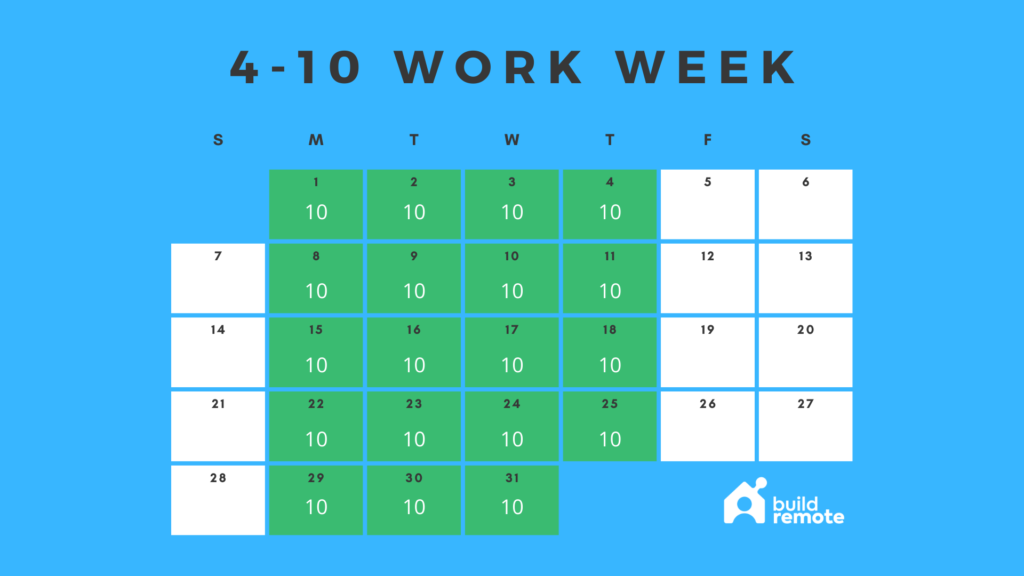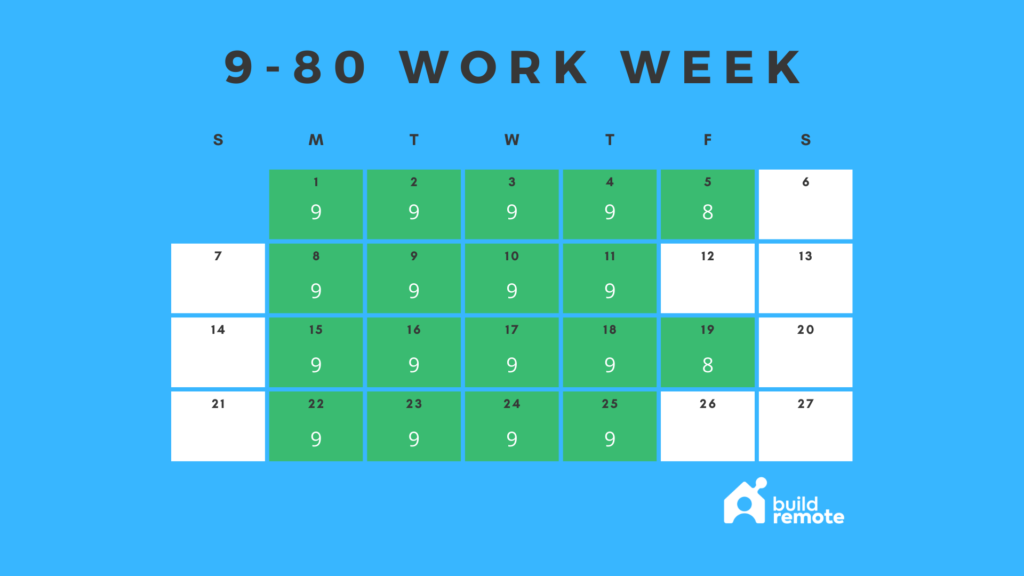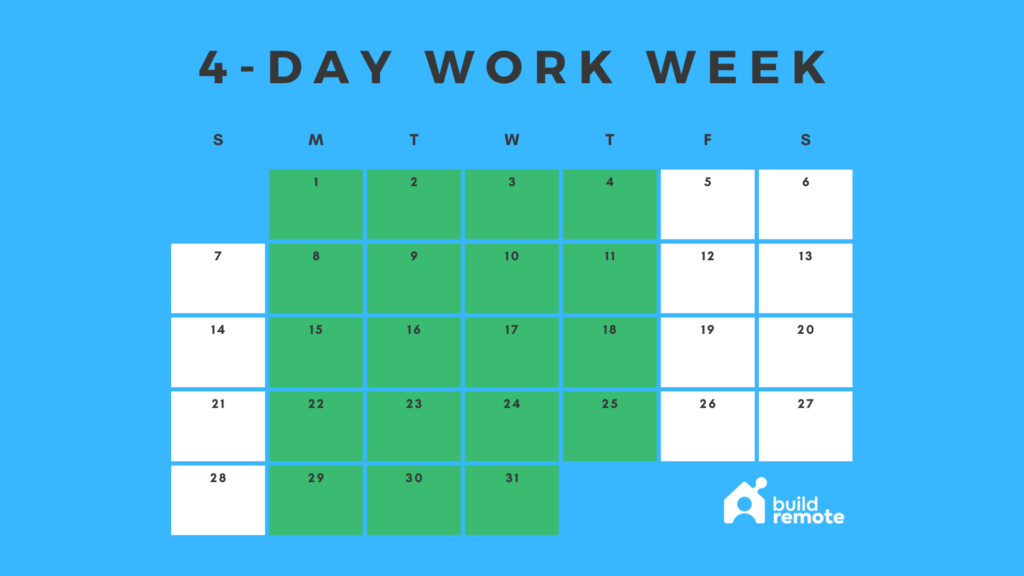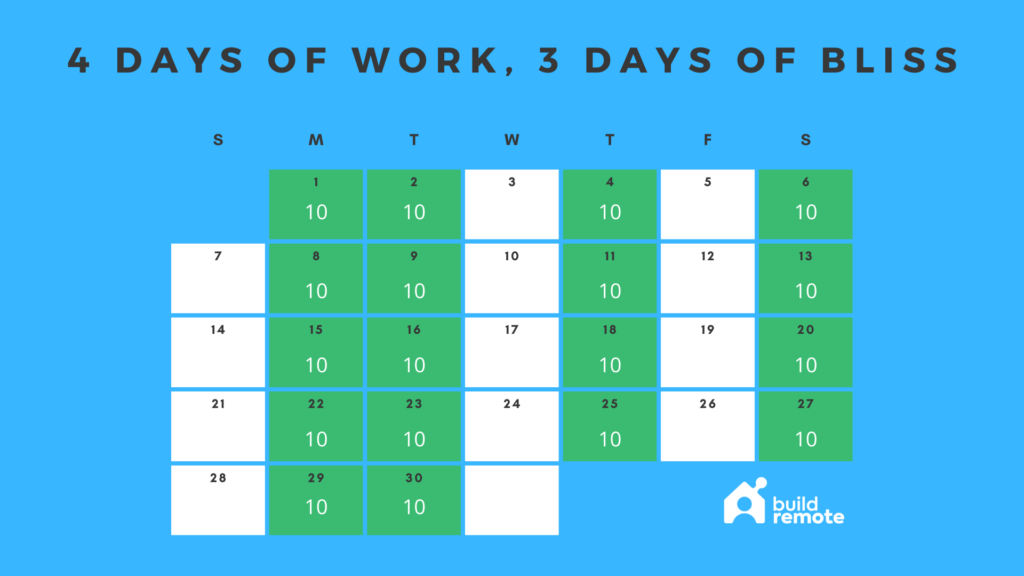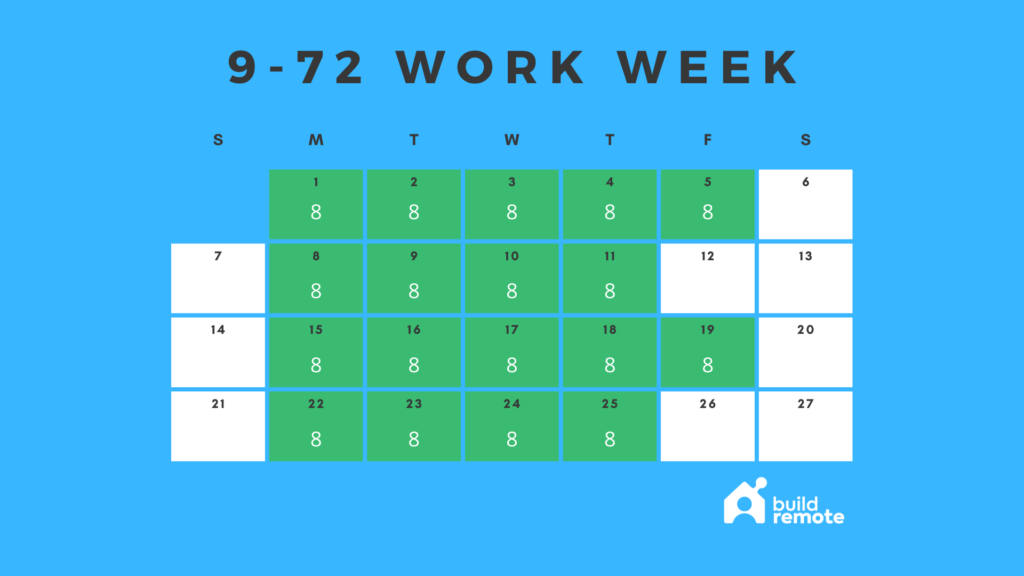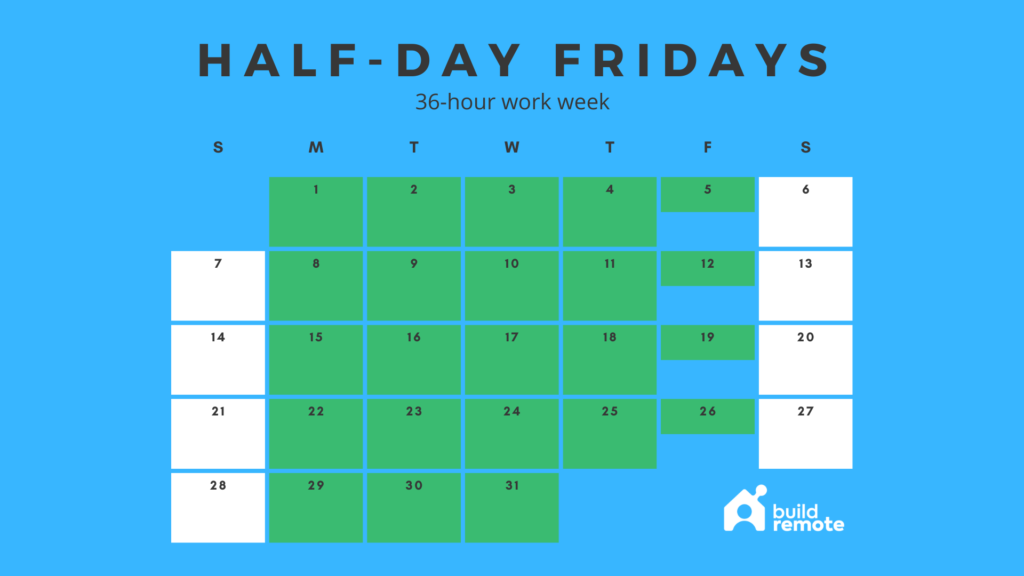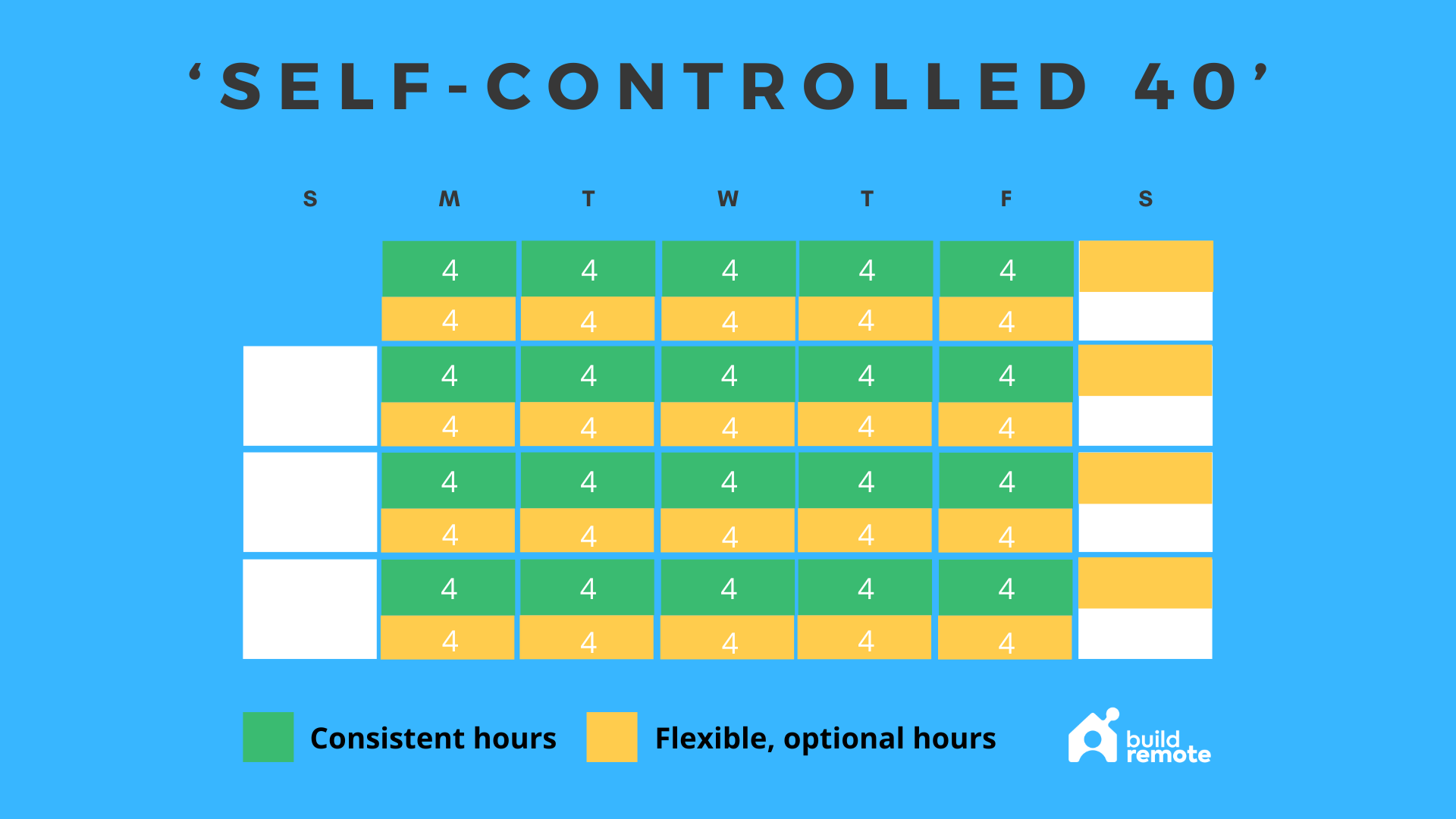The 40-Hour Work Week: Past, Present, & Future
For most working Americans, the 40-hour work week has always been the norm, just the way things are and always have been in their living memory. Working 40 hours a week is the norm in most other countries in the world as well. Why is that? And how and when was the 40-hour work week created?
In this article, I’ll trace the history of the 40-hour work week, looking at who created the 40-hour work week and why it was adopted.
But I’ll also be doing a deeper dive on what I think is a much more interesting topic: the 40-hour work week myth. Is there some immutable reason for working 40 hours a week in eight hour shifts, or are there better ways to organize our labor? After we look at how we got here, we can evaluate whether or not five work days and 40 hours a week should be the standard for everyone, and if not, what the alternative schedules are.
Click a link below to jump to a section that interests you:
- 40-hour work week history
- 40-hour work week laws
- The future of the 40-hour week
- Alternatives to the 40-hour week
- Non-traditional 40-hour schedules
- Common questions
40-Hour Work Week History
Although none of us can remember a time before the 40-hour work week, it hasn’t always been the standard operating model.
Prior to the Industrial Revolution, most people farmed and did whatever work needed to be done when it was time to do it, and the length of the workday was determined by the sun. People worked longer hours in the summer growing season and less in the winter when daylight hours were short and the fields were fallow.
Industrialization turned all of that on its head. As it gathered “full steam” in the 18th century, the cadence of work that most of humanity had followed for millenia abruptly changed, starting in England and soon expanding to America and the rest of Europe.
Here’s how the Industrial Revolution unfolded:
- C. 1710: Thomas Newcomen invented a steam engine to operate mine pumps in Wales.
- 1769: James Watt patented an improvement to the Newcomen steam engine. Watt’s engine would power the Industrial Revolution, driving everything from factories to steamships and locomotive engines.
- 1775: Richard Arkwright used Watt’s engine to power mechanized textile production in England.
- Arkwright was later recognized as the inventor of the modern factory system, where work was organized into shifts determined by the clock, not the sun or season.
- 1790: Industrialization got underway in the United States, when Arkwright associate Samuel Slater built versions of Arkwright’s machinery from memory and established a cotton mill in Rhode Island, in the first known case of industrial espionage.
The industrial factory system changed not only how work was done, but when and where it was done. Prior to industrialization, people produced goods at home or in small workshops using hand tools, working at their own pace.
In a mechanized factory, however, the pace of production was dictated by the machines. To keep a mechanized production system moving, all the necessary workers had to be at their posts at the appointed time. Factory owners solved this problem by organizing work shifts to begin and conclude at specific times. And for almost 150 years after the start of the Industrial Revolution, typically those shifts were long.
It was not unusual for factory workers of the 18th and 19th centuries—including women and children—to work shifts of 12 to 16 hours, six days per week. The hours were grueling and the pay was low, which led to the first calls for better working conditions within the first 50 years of industrialization.
Although it took a century for conditions to radically improve, this was the genesis of the 40-hour work week:
- 1817: British social reformer Robert Owen proposed the first approximation of the 40-hour work week, with the slogan “Eight hours labor, eight hours recreation, eight hours rest.”
- 1884: The push for the eight-hour workday gained momentum in the U.S. through the advocacy of the Federation of Organized Trades and Labor Unions, a precursor to the American Federation of Labor (AFL).
- 1926: It was Henry Ford who finally received the main share of credit for “inventing” the 40-hour work week when he adopted a five day, 40-hour week for Ford Automotive Company production line workers.
- 1938: The 44-hour work week became the standard in the U.S. with the passage of the Fair Labor Standards Act (FLSA).
- 1940: The FLSA was amended to reduce the standard work week to 40 hours.
40-Hour Work Week Laws
The FLSA doesn’t stipulate that “full time” is a 40-hour work week as a matter of law. Instead it requires that workers be paid overtime for any hours in excess of 40 that they work in any given week.
As a result, there really are no hard and fast definitions of full time or part time work in U.S. law. Is 30–35 hours per week part time, or full time? It depends on who you ask. But in the absence of any legal definition stipulating that full time work is 40 hours per week, one thing is clear:
The definition of “full time” work as only 40 hours (or more) per week is something we’ve adopted as a result of custom; it is not carved in stone.
Internationally, the definitions for part time and full time work vary, though most countries’ standards for full time work cluster around 40 hours per week, plus or minus eight hours. Here’s how things stand in the 50 countries with the biggest economies:
| Country | 2021 GDP | Full-Time Week | Part-Time Week | Learn More |
|---|---|---|---|---|
| United States | $22,997,500,000,000 | > 30 Hours On Average (130 Hours Per Month) |
< 30 Hours (< 130 Hours Per Month) |
irs.gov |
| China | $17,458,040,000,000 | 40 Hours | < 25 Hours | hrone.com |
| Japan | $4,937,420,000,000 | 40 Hours | < 40 Hours | jetro.go.jp |
| Germany | $4,225,920,000,000 | 36 – 40 Hours | < 30 Hours | iamexpat.de |
| United Kingdom | $3,187,630,000,000 | > 35 Hours | < 35 Hours | gov.uk |
| India | $3,177,920,000,000 | > 30 Hours | < 30 Hours | faqs.in.gov |
| France | $2,935,490,000,000 | 35 Hours | < 35 Hours | expatica.com |
| Italy | $2,101,280,000,000 | 40 Hours | < 40 Hours | accountingbolla.com |
| Canada | $1,990,760,000,000 | 40 Hours | < 40 Hours | canada.ca |
| Korea | $1,798,540,000,000 | 40 Hours | < 40 Hours | replicon.com |
| Russia | $1,775,550,000,000 | 40 Hours | < 40 Hours | replicon.com |
| Australia | $1,633,290,000,000 | > 35 Hours | < 35 Hours | abs.gov.au |
| Brazil | $1,608,080,000,000 | 40 – 44 Hours | < 40 Hours | boundlesshq.com |
| Iran | $1,426,300,000,000 | 44 Hours | < 44 Hours | faramalaw.com |
| Spain | $1,426,220,000,000 | 40 Hours | < 40 Hours | expatica.com |
| Mexico | $1,294,830,000,000 | 48 Hours | < 40 – 48 Hours | replicon.com |
| Indonesia | $1,186,070,000,000 | 40 Hours | < 40 Hours | replicon.com |
| Netherlands | $1,018,680,000,000 | 36 – 40 Hours | 12 – 36 Hours | thelifenet.eu |
| Saudi Arabia | $833,541,000,000 | 48 Hours | < 40 – 48 Hours | replicon.com |
| Switzerland | $812,552,000,000 | 45 Hours | 90% Of A Full-Time Employee | iamexpat.ch |
| Turkey | $806,804,000,000 | 45 Hours | < 31 Hours | turkishlaborlaw.com |
| Poland | $674,127,000,000 | 40 Hours | < 40 Hours | boundlesshq.com |
| Sweden | $627,438,000,000 | 40 Hours | < 40 Hours | arbetsformedlingen.se |
| Belgium | $599,989,000,000 | 40 Hours | < 40 Hours | employment.belgium.be |
| Thailand | $513,165,000,000 | 48 Hours | < 40 – 48 Hours | replicon.com |
| Ireland | $498,891,000,000 | 40 Hours | < 35 Hours | citizensinformation.ie |
| Norway | $482,437,000,000 | 40 Hours | < 40 Hours | nho.no |
| Israel | $481,591,000,000 | 42 Hours | < 42 Hours | replicon.com |
| Austria | $477,400,000,000 | 38.5 Hours | < 21 Hours | welcomm-europe.eu |
| South Africa | $418,020,000,000 | 45 Hours | < 30 – 35 Hours | mywage.co.za |
| Egypt | $402,838,000,000 | 48 Hours | < 40 – 48 Hours | hg.org |
| Singapore | $396,992,000,000 | 44 Hours | < 35 Hours | mom.gov.sg |
| Denmark | $395,710,000,000 | 37 Hours | < 37 Hours | english.ida.dk |
| Philippines | $393,612,000,000 | 40 Hours | < 40 Hours | outsourceaccelerator.com |
| Malaysia | $372,754,000,000 | 45 Hours | 30% Of A Full-Time Employee | replicon.com |
| Hong Kong | $368,137,000,000 | 40 Hours | < 40 Hours | hk.indeed.com |
| Vietnam | $366,201,000,000 | 48 Hours | < 40 Hours | mondaq.com |
| Bangladesh | $357,099,000,000 | 48 Hours | < 40 – 48 Hours | globalpeoplestrategist.com |
| Pakistan | $347,743,000,000 | 48 Hours | < 40 – 48 Hours | paycheck.pk |
| Chile | $316,864,000,000 | 45 Hours | < 31 Hours | replicon.com |
| Colombia | $314,268,000,000 | 48 Hours | < 40 – 48 Hours | replicon.com |
| Finland | $298,868,000,000 | 40 Hours | < 40 Hours | infofinland.fi |
| Romania | $283,476,000,000 | 40 Hours | < 40 Hours | replicon.com |
| Czech Republic | $282,641,000,000 | 40 Hours | < 40 Hours | replicon.com |
| Portugal | $250,053,000,000 | 40 Hours | < 40 Hours | boundlesshq.com |
| New Zealand | $247,685,000,000 | 35 – 40 Hours | < 35 Hours | employment.govt.nz |
| Peru | $224,725,000,000 | 48 Hours | < 21 Hours | bizlatinhub.com |
| Greece | $216,384,000,000 | 40 Hours | < 40 Hours | replicon.com |
What is the future of the 40-hour work week?
The 40-hour work week myth (in our current age)
“Why should I plant, when there are so many Mongongo nuts in the world?”—response of a !Kung Bushman, when asked by anthropologist Richard B. Lee why he didn’t settle down and farm.
Why, indeed?
Lee’s study revealed that among the hunter/gatherer tribes of the Kalahari Desert, the people worked only 12 to 19 hours per week in hunting and gathering food—and only people between the ages of roughly 20 and 45 did the work of finding food for everyone.
The !Kung man’s response has alternatively been translated as “Why should I work for a living, when there are so many Mongongo nuts in the world?” The vagaries of translation between the !Kung language of clicks and English being what they are, either translation fits—what the man wanted to know was…
Why would I work so much harder to grow food and chain myself to a single location and a schedule, when there’s so much food just laying around waiting for me to pick it up when I need it?
The original condition of humanity was to work only as much as was necessary to get the food needed to survive. The Agricultural and then the Industrial Revolution changed the nature of work—the first by tying it to a specific location and the latter by tying it to the clock.
The logic of the factory shift carried over into desk and service jobs.
In many ways it made sense to standardize hours of business for everyone in the days of typewriters and telephones; collaborative work required physical proximity.
But with the internet, that is no longer the case. Knowledge work, even collaborative knowledge work, does not require shifts or offices.
The COVID pandemic lockdowns underlined the point indelibly:
- Remote work: When desk job workers were pushed into remote work, after several months of adjustment, both productivity and employee engagement increased.
- Then, flexible schedules: For employees working from home where their families were also isolating, the nine-to-five workday had to become more flexible to accommodate the demands and realities of workers’ lives.
- Then, asynchronous work: With remote workers working flexible hours, asynchronous communication became the norm for many workers and businesses.
- Then, fewer offices: Offices became obsolete for employees working from home.
- While return to the office once seemed inevitable, remote and hybrid work arrangements continued to gain market share, even as the pandemic officially ended.
The standard 40-hour work week is not just dying; for many workers, it is already dead.
Remote work, flexible schedules, and asynchronous communication put workers in the enviable position of the !Kung Bushman—devoting only as much of their time as necessary to do the work they need to get done, and free from being tethered to a specific physical location or the clock. At the same time, the flexibility of remote work offers knowledge workers the opportunity to work for themselves and pursue the projects that most interest them.
In the future, it’s likely that most knowledge workers will be freelancers, working for themselves remotely and on their own schedules and collaborating with other self-employed people to get work done.
Alternatives To The 40-Hour Work Week
While the standard 40-hour week is becoming a thing of the past for many workers, there are alternative work schedules that preserve the 40 hours while deviating from the standard eight hours per day, five days a week, 50 or so 40-hour work weeks in a year.
How many hours a day is 40 hours a week? That depends:
A 4/10 work schedule compresses 40 hours into four 10 hour workdays
What is the 4-10, compressed schedule?
The full-time employees at a company work four days per week with 10-hour work days. This compresses a typical 40-hour work week from five days into four, giving the company the same amount of hours but in fewer days.
See Also: Calculate Hours Worked Between Dates
Here’s a common format:
- Monday: 8-6
- Tuesday: 8-6
- Wednesday: 8-6
- Thursday: 8-6
- Friday: Off
The 9/80 work schedule compresses 80 hours (or 10 eight hour days of work) into nine working days
What is the 9-80 (also known as the 5-4/9) schedule?
A 9-80 work schedule isn’t technically a four-day work week since every other week has four working days. But this is a common, alternative schedule that companies consider to mix up the standard work week.
Over a two-week period, the full-time employees work a normal 80 hours. But instead of working 10 business days, the company works nine. Like the 4-10 schedule, the 9-80 schedule compresses the same amount of hours into fewer days. Typically, the company would give every other Friday off and then spread those eight hours that were missed over the other nine days. Here’s a common format:
Week 1
- Monday: 9-6
- Tuesday: 9-6
- Wednesday: 9-6
- Thursday: 9-6
- Friday: 9-5
Week 2
- Monday: 9-6
- Tuesday: 9-6
- Wednesday: 9-6
- Thursday: 9-6
- Friday: Off
Some businesses have ditched the 40-hour standard and opted for a four day, 32 hour workweek
What is the 4-day work week schedule?
The company has four working days per week rather than five and each day consists of the normal eight-hour work day. That makes for a 32-hour work week (and a three-day weekend) for the full-time employees at that company.
When people talk about the four-day work week, they are typically referring to this schedule. In most cases, companies would remove Friday from the work week. Here’s a common format:
- Monday: 9-5
- Tuesday: 9-5
- Wednesday: 9-5
- Thursday: 9-5
- Friday: Off
See Also: Business Days Calculator
Other ways to think about your work schedule
- Flexible work schedules allow each employee to set his or her own daily schedule; some may choose to work 6 am – 2 pm, while others might work from 10 am – 6 pm, and other employees may choose to work 10 hours one day and six hours the next. It’s up to the employee to determine how they will structure their 40 hours of work.
- Asynchronous work in some cases entirely dispenses with the notion of a set number of work hours per week. The asynchronous workplace is oriented toward task completion rather than the number of hours worked; because workers are all working on their own assigned work tasks with their own deadlines, getting the work done correctly and on time is all that matters.
See Also: The Ultimate Work Schedule Template Library
Non-Traditional 40-Hour Schedule Examples
If you’d like to continue working about forty hours per week, but you’d like to insert some creativity and flexibility, you’ll find some non-traditional 40-hour schedules in this section.
I asked our list of contributors to share their weekly work schedules if they 1) work about 40 hours per week but 2) in a non-traditional format. I got 48 replies and we’re highlighting the best ones here that range from 35-50 hours per week.
‘4 days of work, 3 days of bliss’
40 hours per week over Monday, Tuesday, Thursday, Saturday
I usually only work four days a week for 10 hours each. I love having three days off, so I try to strive for this every week.
This change has made such a big difference in my life. I have more time to spend with my friends and family, more time for the gym and to relax. I am much more focused when I work, and find I have not been exhausted for quite some time.
– Donny Gamble of PersonalIncome.org
See Also: Average Work Hours Per Week For Every Country
9-80 work schedule (5-4/9 schedule)
80 hours over a two-week period (with every other Friday off)
During a two-week period, the employee works 80 hours across nine days instead of ten. The plan is to spread eight hours of work, typically done on a Friday, across the other nine days in the period to earn an extra day off every other week. The most common way to do this is four nine-hour days followed by an eight-hour Friday. The next week is four nine-hour days followed by a Friday off.
9-72 work schedule
40-hour week followed by a 32-hour week (every other Friday off)
This is where employees have a normal five-day, 40-hour week followed by a four-day, 32-hour week. In other words, every other Friday is off with normal work days outside of that. If you have positions that are required to be on during normal work hours (like client work or support), you could have half of your team on each Friday for coverage.
Half-day Friday policy (36-hour work week schedule)
36 hours over five days (half days on Friday)
Full-time employees work 36 hours per week rather than 40. Typically, the work day ends at lunch time on Friday to meet the allotted time. The opportunity here is to give people a compressed amount of time to work on Friday, then enjoy the afternoon off. Typically, Friday afternoons are the least productive time.
Read more about the half-day Friday work schedule.
‘Time for the outdoors’
40 hours per week over Tuesday, Wednesday, Friday, Saturday
I basically work 38-40 hours across four days. I work a standard eight-hour day starting at 8:00 AM and finish at 4:00 PM. I then take a two-hour break to spend on some kind of sporting activity like surfing, hiking, running or cycling. Then I come home, shower, and have supper. I then do another two-hour session from 8:00 PM to 10:00 PM.
This work schedule gives me a day off to do what I love, and ends work earlier to capitalize on the remaining daylight.
– Marc Mason of Beginner Surf Gear
’10-5′
40 hours per week over Monday, Wednesday, Friday
I work Mondays, Wednesdays, and Fridays, and take care of non-work tasks and responsibilities on Tuesdays and Thursdays. I work 10 hours or more on Mondays, Wednesdays and Fridays to compensate for my time off on Tuesdays and Thursdays.
I realized that I needed to offer more flexibility in terms of the time that I could allot to help my wife at home, and this schedule works for us.
– Ian Sells of RebateKey
‘As you go’
35 hours per week over Monday, Tuesday, Thursday, Friday, Sunday
I have a detailed list of tasks per day, but I make sure there is at least an hour or two per day reserved for ‘surprise’ tasks – which, in my line of work, always come up last-minute.
I need a day free during the week to accommodate a change in schedule (a trip to the dentist or doctor for myself or the kids, to attend a meeting with a teacher, etc.) If I have any remaining work on Friday, then I work a half day on Sunday.
– Geninna Ariton of Trendhim
‘When the inspiration strikes’
40 hours per week over Monday, Tuesday, Thursday, Friday, Saturday, Sunday
I try to complete all the tasks for my clients within a 4-day workweek. This takes me approximately 35-40 hours, and I don’t force my work (since it is all written). I also work 2 days out of the week on my own personal and professional development, which usually tallies about 15-20 hours depending on my productivity. Stacking my tasks keeps me accountable to deadlines, and also means I can keep enough time in the schedule to work on building my own blog audience, submitting pitches to other publications, and staying up-to-date on continuing education in my field. I found that I not only have more creative impulses, but also have the energy to follow through on them.
– Ashley Schuering of Confessions of a Grocery Addict
‘Two blocks’
45 hours per week over Monday, Tuesday, Wednesday, Thursday, Friday, Saturday
Monday to Friday: 7:00 AM – 12:30 PM, 2:30 PM – 5:30 PM (8.5 Hours/Day) Saturday: 7:00 AM – 11:00 AM (4 hours If needed)
My first child was recently born, and I had to rethink my schedule so I could spend more time with her. With my new schedule, I now have a large block during the day where I play with my daughter, eat lunch, and spend time with my wife.
– Cody Richard of Full Circle Homebuyers
‘Flexible schedule‘
40 hours per week over Monday, Tuesday, Wednesday, Thursday, Friday
Though I work a normal five-day week, I take longer breaks throughout the day, and often end early on Friday around the lunch hour. I’ve found that I’m most productive when I work in blocks of an hour to a few hours, rather than sitting in front of my computer for a long stretch of time.
– Kathryn Boudreau of CallerSmart
‘Self-controlled 40’
Up to 40 hours per week over Monday, Tuesday, Wednesday, Thursday, Friday, Saturday
- First 20 hours: 9:00 AM – 1:00 PM each weekday
- Remaining 20 hours (optional): 4:00 PM- 8:00 PM slots
Sometimes these are shortened, skipped or extended. Sunday is a non-negotiable free day. Saturday is usually free, but I have found that I sometimes have energy left for some catch-up work.
– Kaelum Ross of What in Tech
‘The five-day special’
40 hours per week over Monday, Tuesday, Wednesday, Saturday, Sunday
“I work three ten-hour days (Monday to Wednesday), five hours on a Saturday, and five hours on Sunday to catch up on paperwork. I call it the five day special — it leaves a two-day block free to enjoy some much needed downtime. The new schedule has made me more efficient, easier to be around and a better person, both personally and professionally.
– Michael Rose of Hach & Rose
‘The on-and-off 10 and 12’
44 hours per week over Monday, Tuesday, Wednesday, Thursday
I work on-and-off 10 and 12 — 10 hours on Mondays, 12 on Tuesdays, then 10 on Wednesdays and 12 on Thursdays.
By electing to put in the hours that I need to during the first four days of the week, I can be a full time parent on Friday and attend my children’s games and recitals, and just spend some positive time with them on the weekends. I’m the firm manager, and I have the luxury of being able to set my own hours.
– Ross Jurewitz of Jurewitz Law Group
‘Friday lite’
45 hours per week over Monday, Tuesday, Wednesday, Thursday, Friday
I embrace a Friday-lite approach to the end of the workweek. Crushing it Monday through Thursday allows me to spend Fridays in solitude, planning for the week ahead.
I’m much more relaxed without the distractions of phone calls, messages, and meetings. It also allows me the opportunity to go out to lunch with my wife on a weekday, which is the kind of work break I like best.
– Jason Sherman of TapRm
‘4-day with a break in the middle’
35 hours per week over Monday, Tuesday, Thursday, Friday
I schedule my week over four days — Mondays, Tuesdays, and then Thursdays and Fridays. This allows me to take a breather in the middle of the week, and I don’t become overwhelmed. It also allows me and my employees to set up meetings in a manner that suits our team’s schedule, and it gets the work done with minimal chance of burnout.
COVID played a big factor in deciding this. It has made my work-life balance much better and has given me time and energy to focus on my passion projects and bring new life into my work.
– David Farkas of The Upper Ranks
‘Life-work balance’
40 hours per week over Monday, Tuesday, Wednesday, Thursday, Friday, Saturday, Sunday
As long as I get all of my tasks done on time, there are no specific times they need to be done. So I generally look at my week and block out times in my calendar for all of the important life things I want to prioritize, whether that’s workouts and appointments or something as simple as a dog walk. I work out the best time to schedule work, and assign tasks to certain times based on how I’m feeling, my creativity levels, and other factors. This means I’m giving 100% at all times. When I’m working, I am focused completely on my work. When I’m not, I try to switch off and recharge.
– Ruby Willow of Financer.com
‘Global 7-3’
50 hours per week over Monday, Tuesday, Wednesday, Thursday, Friday
“My focus is to always be in the moment. My teams are scattered across the globe. I ensure collaboration happens by breaking up the workday. My head and body usually need rest, so I will take an afternoon siesta or a break midday. I keep office hours and family separate, and that is a hard and fast rule. My schedule is M-F, 8-3pm and 10pm – 1am. This allows me to give my work and my family my undivided attention.
– Dr. Subodh Simon Karmarkar of Refundwiz LLC
‘The 8-6 schedule’
40 hours per week over Tuesday, Wednesday, Thursday, Friday
As a psychologist, I tend to work a lot with other people, and a lot of what I do is dependent on the availability of my clients. This can mean working late to accommodate clients that work during the day. More often than not, I work between 8am and 8pm, but only 4 days a week.
Working this schedule means that I can be available more for my clients’ needs, but it also means that I can work 4 days a week instead of 5. This gives me more free time to create a healthier work/life balance.
– Alexander Burgemeester of The Narcissistic Life
‘A little bit each day’
45 hours per week over Monday, Tuesday, Wednesday, Thursday, Friday, Saturday, Sunday
Balance is the main reason I have decided to work this schedule. I love getting up early and working out, as well as ending my day early to cook dinner and get outside. I feel happier and more productive each day because it doesn’t feel like a grind. I typically work a half day Saturday and quarter day Sunday mainly because I love what I do but also to give myself a more prolonged break from work to reset my mind.
– Andy Kolodgie of The House Guys
I work with clients who are buying homes. They are looking for houses during their off hours, so I need to be available to them on weekends or evenings. During the day I’ll push my loans through the process. I work a little each day, but overall I don’t work more hours than a regular job. I like this schedule as it affords me so nice breaks throughout the day.
– Jeffrey Loyd of Mortgage Acuity
See Also: The 60-Hour Work Week | Work From Home, Make Your Own Schedule Jobs
Common Questions About The 40 Hour Work Week
What is the most common 40-hour work week schedule example?
A typical full-time work schedule is Monday – Friday, 9:00 AM – 5:00 PM (or 6:00 PM if lunch is not counted toward working hours).
Who invented the 40-hour work week?
Henry Ford.
During the Industrial Revolution, factory workers often worked 80-100 hours per week. Employees were worked to the bone. In 1926, Henry Ford switched the Ford Motor Company factory schedule to five, eight-hour days without a decrease in pay. Henry Ford discovered through his research that “working more yielded only a small increase in productivity that lasted a short period of time,” according to Culture Amp.
The 40-hour work week clearly existed before 1926 depending on the country or company, but the way we now think of it has its origins from the Ford Motor Company.
When did the 40-hour work week start?
May 1, 1926.
This is the day Henry Ford adopted a five-day, forty-hour work week for his factory workers. In August of 1927, Ford implemented the same schedule for its office workers. Shortly thereafter, other US manufacturers then ones from around the world implemented the same 40-hour work week that we are accustomed to today.
When was the 40-hour work week established?
1926 – 1940
- 1926: Henry Ford implemented the Monday-Friday, 40-hour work week for his factory workers. Other companies around the country quickly followed.
- 1938: On Saturday, June 25, 1938, President Franklin D. Roosevelt signed the “Fair Labor Standards Act of 1938 (FLSA).” For certain industries, this act set the minimum hourly wage at 25 cents, and the maximum workweek at 44 hours. Companies would have to pay overtime above 44 hours.
- 1940: The 44-hour threshold was lowered to 40 hours, essentially making the 40-hour work week a law. The purpose was to reduce unemployment by encouraging employers to hire more workers rather than pay fewer workers more overtime.
Why do we work 40 hours a week?
Henry Ford set the precedent in 1926.
Henry Ford popularized the 40-hour work week in 1926. Other companies followed his lead in the years after that. Then, in 1938 the US voted on the FLSA act to set 44 hours as the maximum hours per week before overtime needs to be paid. In 1940, that was reduced to 40 hours. Since then, we’ve essentially been operating on the 40-hour work week as the default.
What is a 40-hour work week?
The 40-hour work week is the most typical schedule worked by employees. The working days are Monday through Friday. Each day consists of eight hours of work.
See Also: How Many Work Days Are In A Year?
How many work hours, days, and weeks are in a year for a 40-hour work week?
- How many work hours are in a year?
- How many days are in a year?
- How many work weeks are in a year?
- How many weekends are in a year?
Where to find alternative schedule jobs
If your current job doesn’t allow for the flexibility you’d like, remember: we’re in a job applicant’s market! If you’d like to see what’s out there for flex-schedule positions and companies, take a look at Flexjobs. You’ll find dedicated filters to “flexible” and “alternative” schedules.
View other unique work week schedulesThis is part of our series highlighting unique work schedules. Have a look: |
We hope you find this article useful. Just so you know, Buildremote may collect a small share of sales from the links on this page to help keep this site running.


